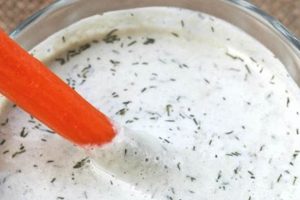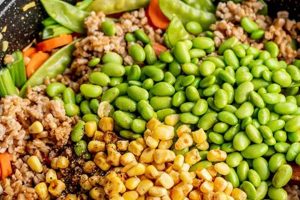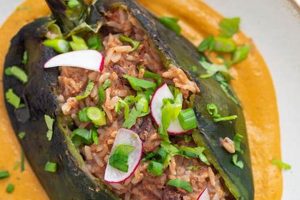A dish composed of seasoned plant-based ingredients served in lettuce leaves instead of traditional wraps or tortillas is a common culinary creation. These typically include a filling of vegetables, plant-based protein sources (such as tofu or lentils), herbs, and sauces, all contained within crisp lettuce cups. As an example, a preparation might involve crumbled tofu, finely diced carrots and bell peppers, water chestnuts, and a savory sauce made from soy sauce, ginger, and garlic, served in butter lettuce leaves.
This particular culinary approach offers several advantages. It provides a lighter, lower-carbohydrate alternative to conventional wraps, which can be beneficial for individuals monitoring their carbohydrate intake or seeking a healthier option. Furthermore, it allows for creative combinations of flavors and textures, facilitating the incorporation of a variety of nutrient-rich vegetables. The history of using leafy greens as edible wrappers can be traced back to various cultures, adapting to local ingredients and dietary preferences over time.
The subsequent sections will detail the components of a successful assembly, offering guidance on ingredient selection, sauce preparation, and optimal techniques for creating flavorful and texturally appealing results. This includes information on sourcing fresh produce, selecting appropriate plant-based proteins, and understanding the nuances of crafting complementary sauces.
Preparation Guidance
The following recommendations aim to enhance the creation of a successful dish and optimize the overall dining experience.
Tip 1: Lettuce Selection: Opt for varieties such as butter lettuce or romaine, chosen for their structural integrity and cup-like shape. These varieties provide ample space for filling and minimize tearing.
Tip 2: Protein Preparation: If utilizing tofu, press it thoroughly to remove excess moisture. This step ensures optimal texture and prevents a soggy final product. Crumbling or dicing the tofu before cooking allows for even browning and flavor absorption.
Tip 3: Vegetable Diversity: Incorporate a variety of vegetables to maximize nutritional content and textural contrast. Consider including crisp elements like water chestnuts or jicama alongside softer ingredients such as bell peppers or mushrooms.
Tip 4: Sauce Consistency: Achieve the desired sauce thickness by adjusting the ratio of liquid to thickening agents such as cornstarch or arrowroot powder. The sauce should coat the filling evenly without being overly runny.
Tip 5: Flavor Balancing: Strive for a balance of flavors, incorporating elements such as acidity (lime juice or vinegar), sweetness (maple syrup or agave), and umami (soy sauce or miso paste). Taste and adjust the sauce throughout the preparation process.
Tip 6: Garnish Considerations: Enhance the visual appeal and flavor profile by adding garnishes. Consider using chopped peanuts, sesame seeds, cilantro, or green onions for added texture and aroma.
Tip 7: Temperature Management: Serve components separately when feasible, allowing diners to assemble their own servings. This prevents the lettuce from wilting due to prolonged contact with warm filling.
These guidelines promote a more appealing and flavorful experience, ultimately resulting in a more successful and enjoyable dish.
The subsequent section will address variations and alternative approaches to ingredients for diverse preferences.
1. Ingredient Substitution
Ingredient substitution constitutes a fundamental element in the adaptation and customization of this dish to meet specific dietary requirements, availability of resources, or personal taste preferences. The dish’s inherent flexibility allows for modifications without compromising its core characteristics, namely, seasoned fillings served within crisp lettuce leaves. For example, individuals with soy allergies may opt to substitute tempeh or lentils for the traditional tofu base, thereby maintaining the protein component while adhering to their dietary restrictions. Conversely, someone may substitute rice noodles for added texture.
The selection of vegetables within the filling also lends itself to considerable variation. Bell peppers, carrots, and mushrooms are common additions, but seasonal produce such as zucchini, summer squash, or even finely diced sweet potatoes can be incorporated to reflect regional availability or personal preference. The sauce, a critical element determining the overall flavor profile, can be adapted through substitutions as well. For instance, substituting maple syrup or agave nectar for honey renders the dish entirely plant-based. Adjusting the quantity of chili garlic sauce or adding alternative spices allows control over the level of heat.
Understanding the principles of ingredient substitution facilitates the creation of a wider range of dishes, tailored to specific needs and desires. While adhering to the underlying concept of a fresh, vegetable-forward wrap, the possibilities remain virtually limitless. The successful application of ingredient substitution relies on an understanding of the flavors and textures of different ingredients, and how they interact within the context of the overall dish, thereby maximizing satisfaction and versatility.
2. Sauce Variation
The character of the filling in this preparation is fundamentally shaped by its accompanying sauce. The sauce provides moisture, cohesion, and, most critically, defines the dominant flavor profile. As such, variations in the sauce directly translate to distinctly different culinary experiences.
- Sweet and Savory Sauces
A primary divergence lies between sweet and savory sauces. A savory approach may incorporate soy sauce, rice vinegar, sesame oil, ginger, and garlic, creating an umami-rich flavor base. This variation is commonly employed in Asian-inspired preparations. Conversely, a sweet rendition could include elements such as hoisin sauce, maple syrup, or brown sugar, lending a sweeter, caramelized flavor. This approach often complements fillings containing grilled or roasted vegetables.
- Spicy Sauces
The inclusion of spicy elements significantly alters the perception. Sriracha, chili garlic sauce, gochujang, or finely diced jalapeos can be incorporated to introduce varying degrees of heat. The level of spiciness can be adjusted to accommodate individual preferences and tolerance. Spicy sauces often pair well with fillings containing cooling elements such as cucumbers or shredded cabbage.
- Creamy Sauces
Creamy sauces provide a contrasting texture to the crispness of the lettuce and the often crunchy filling. Peanut sauce, tahini-based dressings, or cashew cream can be used to create a rich and velvety coating. These sauces add body and enhance the overall mouthfeel. The use of coconut milk can offer a lighter alternative while maintaining the desired creaminess.
- Herbed Sauces
The incorporation of fresh herbs contributes aromatic complexity and freshness. Cilantro-lime sauce, mint-ginger dressing, or basil pesto can be employed to introduce bright, herbaceous notes. The selection of herbs should complement the other ingredients in the filling. These sauces often lighten the overall dish and provide a refreshing counterpoint to richer elements.
The selection of an appropriate sauce is a determining factor in achieving a balanced and satisfying final product. Sauce selection should be made in consideration of the other elements present in filling. Therefore, an astute knowledge of flavor pairings and ingredient interactions is essential in producing a balanced and pleasing final product. The sauce dictates the overall taste which impacts how the main elements come together to the main objective in food preparation.
3. Protein Alternatives
The versatility of the plant-based diet is conspicuously evident in the array of viable protein sources that can serve as core components of the filling. The choice of protein alternative directly influences the nutritional profile, texture, and overall flavor of the final product. Tofu, a staple in many plant-based dishes, offers a neutral base that readily absorbs flavors from accompanying sauces and spices. Tempeh, with its firmer texture and subtly nutty flavor, provides a more substantial bite. Lentils, whether green, brown, or red, offer a source of protein and fiber, imparting a heartier and more filling element to the mixture. Chickpeas, either mashed or left whole, bring a creamy texture and mild flavor that pairs well with a variety of seasonings.
The selection of the most appropriate protein alternative hinges upon individual dietary requirements, taste preferences, and the desired textural outcome. For instance, individuals seeking to maximize their protein intake may opt for quinoa, a complete protein source that also contributes a pleasant nutty flavor and fluffy texture. Those looking to minimize soy consumption might find lentil or chickpea-based fillings more suitable. The practical application of this understanding lies in the ability to customize the dish to align with specific nutritional goals, such as increasing fiber intake by utilizing lentils, or reducing saturated fat content by choosing tofu over certain plant-based meat substitutes. Furthermore, awareness of different protein alternatives allows for creative experimentation, resulting in a wider range of flavor combinations and textural experiences.
In summary, the thoughtful selection of a protein alternative is a critical determinant of the ultimate success of “vegan lettuce wraps recipe”. The range of options available allows for adaptation to diverse dietary needs and preferences, enhancing both the nutritional value and the palatability. The challenge lies in understanding the unique characteristics of each protein source and how they interact with other ingredients. By mastering this understanding, one can create a nearly limitless variety of dishes that are both satisfying and nutritionally balanced.
4. Lettuce Types
The choice of lettuce profoundly impacts the structural integrity and overall palatability. Distinct lettuce cultivars offer varying degrees of pliability, crispness, and flavor, influencing the practicality and aesthetic appeal of the finished product. For instance, butter lettuce, characterized by its soft, pliable leaves, readily forms cups suitable for containing fillings, but it offers limited resistance to moisture and may become soggy if overfilled. In contrast, romaine lettuce, with its rigid, upright leaves, provides a sturdier vessel, better suited for holding heavier or more saucy fillings, but its shape may require more careful arrangement of ingredients. Iceberg lettuce, while possessing a pronounced crispness, is generally less favored due to its relatively bland flavor and tendency to fracture, making it less accommodating for wrapping.
The selection of lettuce should consider the nature of the intended filling. A filling containing a high moisture content, such as a seasoned vegetable medley with a soy-based sauce, may benefit from the use of romaine or even slightly heartier green leaf lettuce to prevent disintegration of the wrap. Drier fillings, such as those composed primarily of crumbled plant-based protein and chopped vegetables, may be adequately contained within the more delicate butter lettuce. The size and shape of the lettuce leaves also play a role; larger leaves offer more surface area for containing fillings, while those with a natural cup-like shape, such as butter lettuce, simplify the assembly process. Real-world examples demonstrate that restaurants specializing in this dish often offer multiple lettuce options, catering to customer preferences and the characteristics of their various fillings.
Ultimately, the successful execution of “vegan lettuce wraps recipe” hinges on an informed selection of lettuce. A mismatch between lettuce type and filling can result in a structurally unsound and aesthetically unappealing final product. While factors such as flavor and nutritional content remain important, the primary challenge lies in choosing a lettuce that provides adequate support and enhances the overall eating experience. An understanding of lettuce characteristics, coupled with careful consideration of filling properties, is thus essential for achieving optimal results.
5. Assembly Techniques
Effective assembly techniques are critical for the successful creation of lettuce wraps. The improper execution of these techniques can lead to structural instability, compromised aesthetics, and a diminished eating experience. Specifically, with “vegan lettuce wraps recipe,” the texture and water content of the filling, frequently composed of chopped vegetables and plant-based proteins, necessitate careful consideration during the assembly process. Overfilling, for instance, can cause the lettuce to tear, resulting in spillage and difficulty in handling. Conversely, insufficient filling may result in a visually unappealing and texturally unbalanced final product. The order in which ingredients are layered also contributes significantly; layering heavier elements at the bottom of the lettuce cup provides a more stable foundation, while lighter elements, such as garnishes, can be placed on top for visual appeal. Restaurants specializing in Asian cuisine often train staff in precise assembly methods to ensure consistency in presentation and structural integrity.
Practical application of these techniques extends to the selection and preparation of ingredients. Finely dicing vegetables and uniformly distributing sauces throughout the filling promotes even weight distribution and minimizes the risk of tearing. Furthermore, allowing excess moisture to drain from the filling prior to assembly can prevent the lettuce from becoming soggy. Securing the wrap, particularly for variations employing larger or more pliable lettuce leaves, may involve folding the sides inwards or using a toothpick to maintain its shape. The user’s dexterity and attention to detail also play a significant role. Individuals with limited experience may benefit from starting with smaller portions and gradually increasing the amount of filling as their proficiency improves. Observing experienced cooks or consulting detailed visual guides can also enhance one’s understanding of optimal assembly procedures.
In summary, the success of preparing a “vegan lettuce wraps recipe” hinges not only on the quality of ingredients and the flavor profile of the sauce but also on the application of sound assembly techniques. These techniques mitigate the risk of structural failure, enhance the visual appeal, and contribute to a more enjoyable and satisfying eating experience. Challenges may arise from variations in lettuce type, filling composition, and individual dexterity. Ultimately, mastering the art of assembly transforms a collection of ingredients into a cohesive and well-presented dish.
Frequently Asked Questions About Vegan Lettuce Wraps
The subsequent section addresses prevalent inquiries concerning the preparation, components, and suitability of a certain plant-based culinary dish.
Question 1: Is it possible to prepare a vegan lettuce wrap without soy-based ingredients?
It is indeed possible. Lentils, chickpeas, or crumbled walnuts can serve as viable protein alternatives to tofu, the soy-derived ingredient. Furthermore, soy sauce can be replaced with tamari or coconut aminos to achieve a similar savory flavor.
Question 2: What is the most effective method for preventing the lettuce leaves from becoming soggy?
Excess moisture is the primary culprit. Ensuring that all filling components are thoroughly drained before assembly is crucial. Serving the filling warm, but not excessively hot, and assembling the wraps immediately prior to consumption will also minimize sogginess.
Question 3: Can a certain culinary dish be prepared in advance, or should it be assembled immediately before serving?
While the filling components can be prepared in advance and stored separately, the final assembly is best performed immediately before serving. This prevents the lettuce from wilting and maintains optimal texture.
Question 4: What are some appropriate dipping sauces that complement the flavor profile?
Options include a peanut sauce, a sweet chili sauce, or a ginger-soy dipping sauce. The choice of sauce should complement the overall flavor profile of the filling, balancing sweetness, acidity, and spice.
Question 5: How does one increase the nutritional value?
Increasing the variety of vegetables within the filling will enhance the nutritional content. Incorporating ingredients such as shredded carrots, bell peppers, and edamame increases the vitamin and mineral content. Furthermore, utilizing whole grains, such as quinoa, as part of the filling provides additional fiber and nutrients.
Question 6: What lettuce varieties work best for creating this dish?
Butter lettuce and romaine lettuce are generally regarded as the most suitable options. Butter lettuce offers a soft, pliable texture, while romaine lettuce provides a more sturdy and rigid structure. Iceberg lettuce is generally discouraged due to its lack of flavor and structural fragility.
The knowledge imparted addresses critical aspects of preparation, ensuring a superior gastronomic result.
The next section offers a step-by-step recipe.
Conclusion
This exploration of “vegan lettuce wraps recipe” has detailed the multifaceted nature of its preparation, emphasizing the importance of ingredient selection, sauce variation, protein alternatives, lettuce types, and assembly techniques. Through careful consideration of these elements, one can successfully create a plant-based dish that is both nutritionally sound and gastronomically satisfying.
The adaptability of the dish allows for significant customization to meet individual dietary needs and preferences. It is expected that the continued rise in plant-based diets will contribute to further innovation within the realm of this preparation, leading to new and exciting variations. The significance of a well-executed plant-based diet remains an avenue for continuing research to improve overall health outcome.







